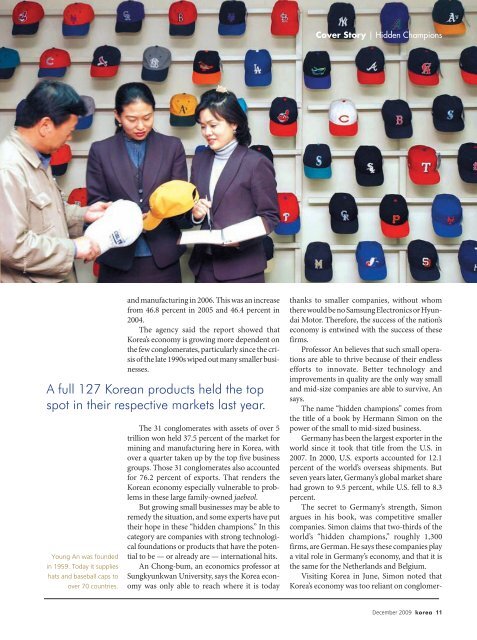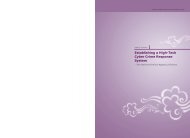2005-2162
12 Innovative Success Stories - Korea.net
12 Innovative Success Stories - Korea.net
- No tags were found...
You also want an ePaper? Increase the reach of your titles
YUMPU automatically turns print PDFs into web optimized ePapers that Google loves.
Cover Story | Hidden Champions<br />
Provided by the company<br />
A full 127 Korean products held the top<br />
spot in their respective markets last year.<br />
Young An was founded<br />
in 1959. Today it supplies<br />
hats and baseball caps to<br />
over 70 countries.<br />
and manufacturing in 2006. This was an increase<br />
from 46.8 percent in <strong>2005</strong> and 46.4 percent in<br />
2004.<br />
The agency said the report showed that<br />
Korea’s economy is growing more dependent on<br />
the few conglomerates, particularly since the crisis<br />
of the late 1990s wiped out many smaller businesses.<br />
The 31 conglomerates with assets of over 5<br />
trillion won held 37.5 percent of the market for<br />
mining and manufacturing here in Korea, with<br />
over a quarter taken up by the top five business<br />
groups. Those 31 conglomerates also accounted<br />
for 76.2 percent of exports. That renders the<br />
Korean economy especially vulnerable to problems<br />
in these large family-owned jaebeol.<br />
But growing small businesses may be able to<br />
remedy the situation, and some experts have put<br />
their hope in these “hidden champions.” In this<br />
category are companies with strong technological<br />
foundations or products that have the potential<br />
to be — or already are — international hits.<br />
An Chong-bum, an economics professor at<br />
Sungkyunkwan University, says the Korea economy<br />
was only able to reach where it is today<br />
thanks to smaller companies, without whom<br />
there would be no Samsung Electronics or Hyundai<br />
Motor. Therefore, the success of the nation’s<br />
economy is entwined with the success of these<br />
firms.<br />
Professor An believes that such small operations<br />
are able to thrive because of their endless<br />
efforts to innovate. Better technology and<br />
improvements in quality are the only way small<br />
and mid-size companies are able to survive, An<br />
says.<br />
The name “hidden champions” comes from<br />
the title of a book by Hermann Simon on the<br />
power of the small to mid-sized business.<br />
Germany has been the largest exporter in the<br />
world since it took that title from the U.S. in<br />
2007. In 2000, U.S. exports accounted for 12.1<br />
percent of the world’s overseas shipments. But<br />
seven years later, Germany’s global market share<br />
had grown to 9.5 percent, while U.S. fell to 8.3<br />
percent.<br />
The secret to Germany’s strength, Simon<br />
argues in his book, was competitive smaller<br />
companies. Simon claims that two-thirds of the<br />
world’s “hidden champions,” roughly 1,300<br />
firms, are German. He says these companies play<br />
a vital role in Germany’s economy, and that it is<br />
the same for the Netherlands and Belgium.<br />
Visiting Korea in June, Simon noted that<br />
Korea’s economy was too reliant on conglomer-<br />
December 2009 korea 11

















